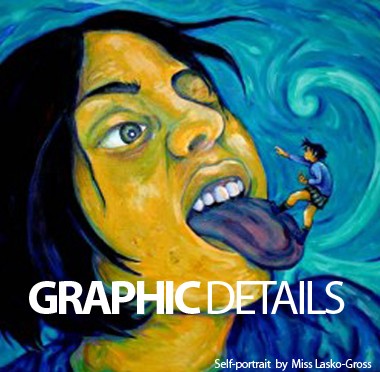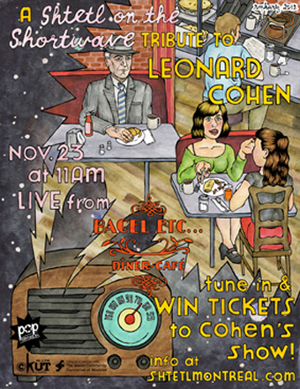
6th February 2007. I was waiting on a bench outside the Tate Modern in London (UK), worrying bitchily about my art career after seeing someone else’s art show, when “Tim”, some hapless chap who just wasn’t that into me, called and bailed. That hurt.
But, as some artists can, and many do in the world of autobiographical comics, I anaesthetised the pain by making drawings about what had happened to me. And one better, I then sold the works – money for heartache is a pretty sound business venture. Now my triptych, “Dumped before Valentine’s” is hanging in Graphic Details: Confessional Comics by Jewish Women, an international touring show I am co-curating with Michael Kaminer, a New-York based (and Montreal-born) comic collector and journalist. As my drawings travel around the world with the works of 17 other international artists, I follow along and, like a parent, I take great delight in how these renderings of my crushed dreams resonate with onlookers.
Graphic Details is a salve for many other ills, not just my own bruised heart. At once deeply personal and even confessional, the work also speaks to the universality of the human condition. The exhibit functions as an important cultural and art historical project, and also as a promoter of the art, power and relevance of comics.
Trina Robbins, active in the first women’s comics groups in the 1970’s, is a world-famous herstorian. Her comics “Big Sis Lil Sis” and “Out of the Closet and Into The Frying Pan” are exhibited in the show. Robbins described how, from November 2005 through March 2006, the Hammer Museum and the Museum of Contemporary Art in Los Angeles presented a major exhibit called American Masters of Comic Art. Robbins explained: “Of the 15 cartoonists represented…there was not one woman in the show.” Kaminer and I are delighted to rectify this oversight, as we write in our curator’s introduction: “The male line in comics is well known but: How did women contribute to the history of comics, and in particular to autobiographical comics, a genre they helped birth?” We are committed to Graphic Details touring internationally with future shows in 2012 including Yeshiva University Museum New York, The Jean Paul Slusser Gallery, Michigan University, Ann Arbor, and, our eyes are set on Europe and Israel for 2013.
Kaminer and I are committed to building an archival reference for years to come, a history, rather a herstory, of Jewish women’s comics. A book about the artists and the exhibit will be published by McFarland next year.
Comics have been undervalued as an art form for too long. We are showcasing these works, framed and contextualised, to impress our viewers with the skill, dexterity and innovation behind the art of comics. Graphic Details predominantly shows original artworks, some leaving the artists’ studios for the first time such as Eisner Award nominee Ariel Schrag’s “The Chosen”, a narrative about renting her flat through a Hassidic realtor.
The seeming simplicity of Schrag’s black and white drawings is misleading, for like other works in the show, they demonstrate a richness of graphics while conveying depths of emotion. The innate honesty of the original comic page invites us into the creative process. Not only do the stories make us privy to the artists’ struggles in their particular lives, but the mark-ups and white-outs where the artists render their experiences, also expose their trials and errors in their work process, making that sheet of paper fraught with narratives.
Aline Kominsky-Crumb, author of what is widely considered the first autobiographical comic “Goldie” published in 1972, proclaims herself to be “the Grandmother of Whiny Tell-All Comics.” Comics have not always been taken seriously as an art form because of their emphasis on super heroics and world saving. Graphic Details reveals how comics portray the superpowers we use just surviving day-to-day living: our embarrassments, vulnerabilities, frailties, ideological and romantic angst that take so much energy during our waking hours, and haunt us during our sleep.
One might question whether the Graphic Details’ artists have much in common aside from their gender? After all, their lives are so different, as are their geographies, ages and artistic styles. Hungarian born Miriam Katin, author of the acclaimed Holocaust memoir “We Are On Our Own”, and whose comic “Eucalyptus Nights” is in Graphic Details, considered this in a J Weekly interview with Rachel Leibold. “At first, Katin wasn’t sure if she was supposed to be sympathetic to her fellow confessional cartoonists. ‘I did a [talk] with [some of the Graphic Details artists in another comics show] in Paris, and was a bit angry, as a [Holocaust] survivor,’ says Katin, 68. ‘These women were born into peace and prosperity. What’s their bitch? What are their problems?’ But as she grew familiar with their work, Katin’s position softened. “Aline Kominsky-Crumb’s parents told her she was ugly,’ Katin says. ‘Everybody has deep, deep pains and questions that take you through life.”’
_______________________________________________________________________

In this audio clip we hear from Laurie Sandell, freelance writer for Glamour, Esquire, GQ, and the author of The Imposter’s Daughter: A True Memoir, a graphic novel about growing up with a father whom she loves dearly, but who has lied to her her whole life about his identity.
[audio:http://www.archive.org/download/LaurieSandell/LaurieSandell.mp3]________________________________________________________________________
There is also the trauma of showing works publicly, with the accompanying fear of scrutiny. Any creative person has experienced the sweaty tremor of taking work from their private space to the public arena. UK- based cartoonist and editor Corinne Pearlman has created a specially made comic for Graphic Details in her regular slot in The Jewish Quarterly “Playing the Jewish Card”. Pearlman has drawn the act of literally opening oneself and revealing what one finds within, on the page. With works that are so intimate and personal, it takes courage for these artists to expose these intimate snapshots. Yet with each empathetic sigh, with each knowing smile, as viewers connect with the comic works, the healing process begins again. “ By revealing your life in comics, you are telling a new story in a new way”, describes Ilana Zeffren, one of the two Israeli artists in the show, whose comic column “Rishumon” appears weekly in an Israeli entertainment magazine. “ You can reach the heart of the reader, even with the smallest anecdote because it’s truthful and your own.”
The sheet of paper has so many possibilities as a site for narrative, and you can see the impressive inventiveness and varied visual language on the walls of The Gladstone Hotel.
Sarah Lightman is an award-winning fine artist, comics researcher, curator, and arts journalist. Sarah creates Diary Drawings, autobiographical drawings and texts, that panel by panel form an ongoing graphic novel of her life. She is the curator of Graphic Details showing at The Gladstone Hotel in Toronto until April 17th,2011. She is also Shtetl’s first ever writer from England!





